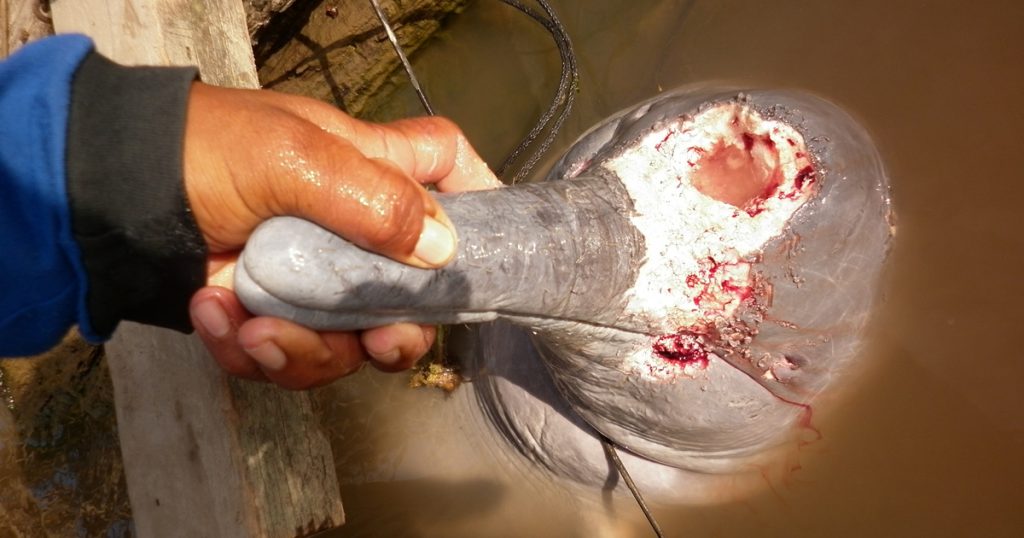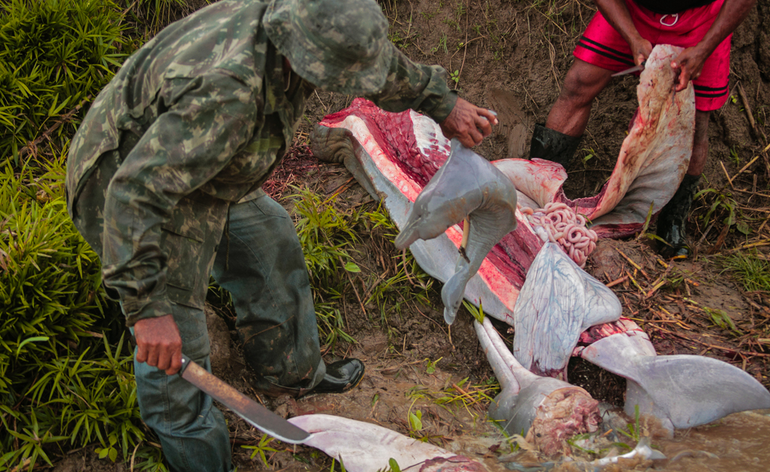At the start of the 2000 deep within the Amazon Jungles the massacre began, even the baby dolphins were not spared nor the gestating females that had their young sliced out of womb hung up like a piece of dead flesh in a butchers shop.
Without hesitation or even a shred of remorse these barbaric monsters pictured here sliced the baby out off the mothers womb flinging it to one side. Brazil has since laid down a hunting ban however poachers are not stopping and already in Peru, Boto’s are mercifully slaughtered just for bait.

Pink River Dolphins or the Amazon River Dolphin as its commonly known scientifically identified as Inia geoffrensis aren’t hunted to eat, oh no, no.
Like many fisherman in the west catch smaller fish to catch the bigger species River Dolphins are caught simply for this reason of which they are butchered up into slabs of meat then thrown back into crates just to catch smaller species of fish commonly known as the piracatinga that feasts on rotten flesh of dead animals – in this case the Dolphin.
You’ve probably by now become quite used to the all to familiar sites of Japans Dolphin massacres – but what about the killing fields within the Amazon?, Some conservationists seem non-to-bothered to print about this, as these bastards rip the hearts and souls out of aquatic life.
At the start of this year some two thousand Amazon River Dolphins were slaughtered as can be seen in the pictures below. However European and South and North American Conservation Groups are taking a stand and have since handed in a 50,000 signature petition in.

While it may stop hunting in Brazil will it stop the poaching? Furthermore will the illegal hunting in Peru, Ecuador, Venezuela, Columbia, Bolivia, Guyana, Surinam and French Guinea stop too.
No one stopped these killings, many people outside off the Amazon are completely oblivious to the fact this horrifying atrocity actually exists. Now you’ll know though, were not going to stick for this anymore. International Animal Rescue Foundation Brazil plus many smaller conservation groups has known of this slaughter for the past several years.
When the Federal government imposed a [temporary ban] five years ago all seemed quiet, unfortunately the hunting ban was lifted with many killed by August, its a wonder if the species will actually recover within this year alone before hunting ends.
Since the start of August though Brazil has imposed a new [complete ban] but this hasn’t as explained stopped poachers and hunters that are now working their way down the rivers of the Amazon.
By the second half of the year [2014] over three and a half thousand River Dolphins were expected to be slaughtered. The number could even be higher as were now in November. what’s angered us even more is this – its completely ILLEGAL!
Sixty percent of the Amazon rain-forest is within Brazil and so Brazil is home to more Amazon River Dolphins commonly known as [Botos] than any other South American country. Botos live in the rivers and lakes of the Amazon and enter the flooded forest during high water season.
The Amazon, and particularly the flooded forest, are threatened habitats. Since the 1980s the rate of deforestation and exploitation of the Amazon Rain-forest for mining, logging, human settlement and cattle ranching has increased significantly. These commercial activities pose a severe threat to the region’s indigenous people and wildlife.
It takes 10 years to reproduce
“Every year, we see in the region Sustainable Development Reserve Mamirauá , the harbor porpoise population decrease by 7.5% per cent. That is not sustainable”, he says.
According to Vera, the aggravating factor is that fishermen prefer young River Dolphins, which hardly ever reach reproductive age. A male dolphin takes 10 years to reach reproductive age and the female between 6 and 7 years. Gestation takes between 11 and 13 months, furthermore, the young mother feeds little ones for two years.
The slaughtering of the young is having a massive impact on the Amazon River Dolphin species of which even with a ban in place will see the entire species wiped out should the world not come together now to enforce a complete in Venezuela, Peru, Columbia, Bolivia, Guyana, Surinam and French Guinea.
The Amazon River Dolphin’s diet mainly consists of piracatinga which is a carnivorous catfish eaten by the locals and indigenous tribes. However humans in the Amazon require 4,500 [Boto’s] to harvest every year piracatinga.
So why is this slaughter not being seen among the western conservation world? Well basically this method of harvesting piracatinga which is [only illegal in Brazil August 2014] only began back in 2000. And despite the entire practice being 100% [illegal] governments and law enforcement agencies are doing little to stop it.

When the fisherman capture the Amazon River Dolphins slaughtering of the dead animal is usually done there and then so that the carcass doesn’t rot to quickly. the carcass is then placed into wooden crates of which the fishermen use to capture the piracatinga fish.
The crates of carved up Dolphin meat inside the crate is then lowered into the water. Fisherman await and the piracatinga fish move in feasting of the dead dolphin rotting carcass. From there its easy pickings for the fishermen.
Its been widely reported in some magazines, articles and media that Brazil has indeed banned this practice which from July [2014] they did. However these media and press reporters [even science based ones] may want to visit the jungles of the Amazon of which this practice is STILL ongoing and has been since 2000.
Conservationists were delighted at hearing the ban announced by the government of Brazil which owns the largest part of the Amazon Rain Forest. “It’s the biggest fisheries ban since 1967 when Brazil’s original faunal protection laws were made,” says Jone César of the Friends of the Manatee Association, a conservation group based in Manaus, Brazil.
Just because Brazil has banned the practice though doesn’t mean for one minute in the rivers of Equador or Peru for example from which the River Dolphin also inhabits and is not within [Brazilian territory] that fishermen will continue the trade.
Furthermore until the Brazilian ban is [completely enforced] its expected that fishermen will kill thousands more Boto’s to store for later fishing. Then of course we have poachers that can and will still flout this ban, and sadly this has already been seen.
We are now many years later and the Amazon dolphin seems to be going extinct soon. The dolphins of the Amazon river have been listed as “Endangered” by the International Union for Conservation of Nature (IUCN) in its latest “Red List” published in November 2018.
Source: Speakupforthevoiceless.wordpress.com





